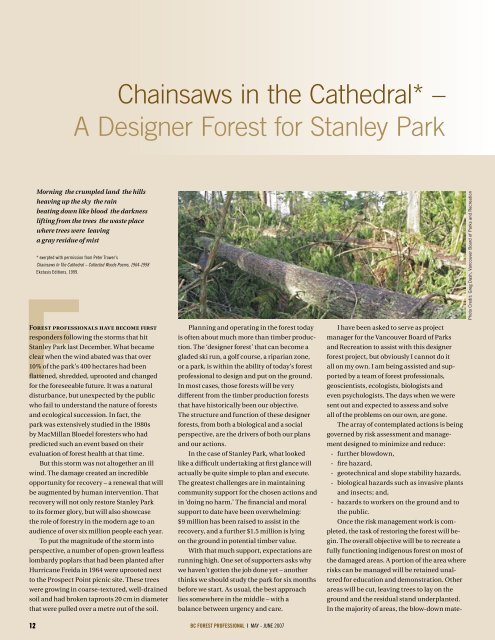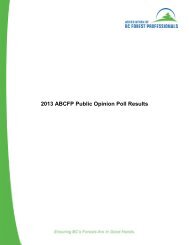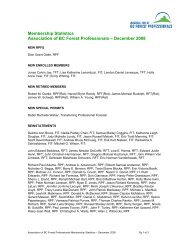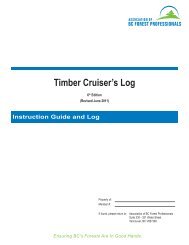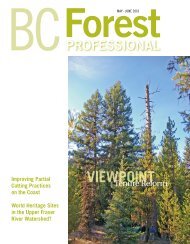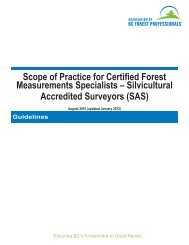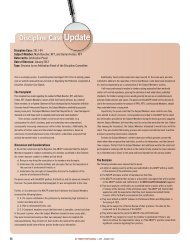T - Association of BC Forest Professionals
T - Association of BC Forest Professionals
T - Association of BC Forest Professionals
You also want an ePaper? Increase the reach of your titles
YUMPU automatically turns print PDFs into web optimized ePapers that Google loves.
Chainsaws in the Cathedral* –<br />
A Designer <strong>Forest</strong> for Stanley Park<br />
Morning the crumpled land the hills<br />
heaving up the sky the rain<br />
beating down like blood the darkness<br />
lifting from the trees the waste place<br />
where trees were leaving<br />
a gray residue <strong>of</strong> mist<br />
* exerpted with permission from Peter Trower’s<br />
Chainsaws In The Cathedral – Collected Woods Poems, 1964-1998<br />
Ekstasis Editions, 1999.<br />
F<br />
<strong>Forest</strong> pr<strong>of</strong>essionals have become first<br />
responders following the storms that hit<br />
Stanley Park last December. What became<br />
clear when the wind abated was that over<br />
10% <strong>of</strong> the park’s 400 hectares had been<br />
flattened, shredded, uprooted and changed<br />
for the foreseeable future. It was a natural<br />
disturbance, but unexpected by the public<br />
who fail to understand the nature <strong>of</strong> forests<br />
and ecological succession. In fact, the<br />
park was extensively studied in the 1980s<br />
by MacMillan Bloedel foresters who had<br />
predicted such an event based on their<br />
evaluation <strong>of</strong> forest health at that time.<br />
But this storm was not altogether an ill<br />
wind. The damage created an incredible<br />
opportunity for recovery – a renewal that will<br />
be augmented by human intervention. That<br />
recovery will not only restore Stanley Park<br />
to its former glory, but will also showcase<br />
the role <strong>of</strong> forestry in the modern age to an<br />
audience <strong>of</strong> over six million people each year.<br />
To put the magnitude <strong>of</strong> the storm into<br />
perspective, a number <strong>of</strong> open-grown leafless<br />
lombardy poplars that had been planted after<br />
Hurricane Freida in 1964 were uprooted next<br />
to the Prospect Point picnic site. These trees<br />
were growing in coarse-textured, well-drained<br />
soil and had broken taproots 20 cm in diameter<br />
that were pulled over a metre out <strong>of</strong> the soil.<br />
Planning and operating in the forest today<br />
is <strong>of</strong>ten about much more than timber production.<br />
The ‘designer forest’ that can become a<br />
gladed ski run, a golf course, a riparian zone,<br />
or a park, is within the ability <strong>of</strong> today’s forest<br />
pr<strong>of</strong>essional to design and put on the ground.<br />
In most cases, those forests will be very<br />
different from the timber production forests<br />
that have historically been our objective.<br />
The structure and function <strong>of</strong> these designer<br />
forests, from both a biological and a social<br />
perspective, are the drivers <strong>of</strong> both our plans<br />
and our actions.<br />
In the case <strong>of</strong> Stanley Park, what looked<br />
like a difficult undertaking at first glance will<br />
actually be quite simple to plan and execute.<br />
The greatest challenges are in maintaining<br />
community support for the chosen actions and<br />
in ‘doing no harm.’ The financial and moral<br />
support to date have been overwhelming:<br />
$9 million has been raised to assist in the<br />
recovery, and a further $1.5 million is lying<br />
on the ground in potential timber value.<br />
With that much support, expectations are<br />
running high. One set <strong>of</strong> supporters asks why<br />
we haven’t gotten the job done yet – another<br />
thinks we should study the park for six months<br />
before we start. As usual, the best approach<br />
lies somewhere in the middle – with a<br />
balance between urgency and care.<br />
12<br />
<strong>BC</strong> FOREST PROFESSIONAL | MAY - JUNE 2007<br />
I have been asked to serve as project<br />
manager for the Vancouver Board <strong>of</strong> Parks<br />
and Recreation to assist with this designer<br />
forest project, but obviously I cannot do it<br />
all on my own. I am being assisted and supported<br />
by a team <strong>of</strong> forest pr<strong>of</strong>essionals,<br />
geoscientists, ecologists, biologists and<br />
even psychologists. The days when we were<br />
sent out and expected to assess and solve<br />
all <strong>of</strong> the problems on our own, are gone.<br />
The array <strong>of</strong> contemplated actions is being<br />
governed by risk assessment and management<br />
designed to minimize and reduce:<br />
- further blowdown,<br />
- fire hazard,<br />
- geotechnical and slope stability hazards,<br />
- biological hazards such as invasive plants<br />
and insects; and,<br />
- hazards to workers on the ground and to<br />
the public.<br />
Once the risk management work is completed,<br />
the task <strong>of</strong> restoring the forest will begin.<br />
The overall objective will be to recreate a<br />
fully functioning indigenous forest on most <strong>of</strong><br />
the damaged areas. A portion <strong>of</strong> the area where<br />
risks can be managed will be retained unaltered<br />
for education and demonstration. Other<br />
areas will be cut, leaving trees to lay on the<br />
ground and the residual stand underplanted.<br />
In the majority <strong>of</strong> areas, the blow-down mate-<br />
Photo Credit: Greg Dash, Vancouver Board <strong>of</strong> Parks and Recreation


